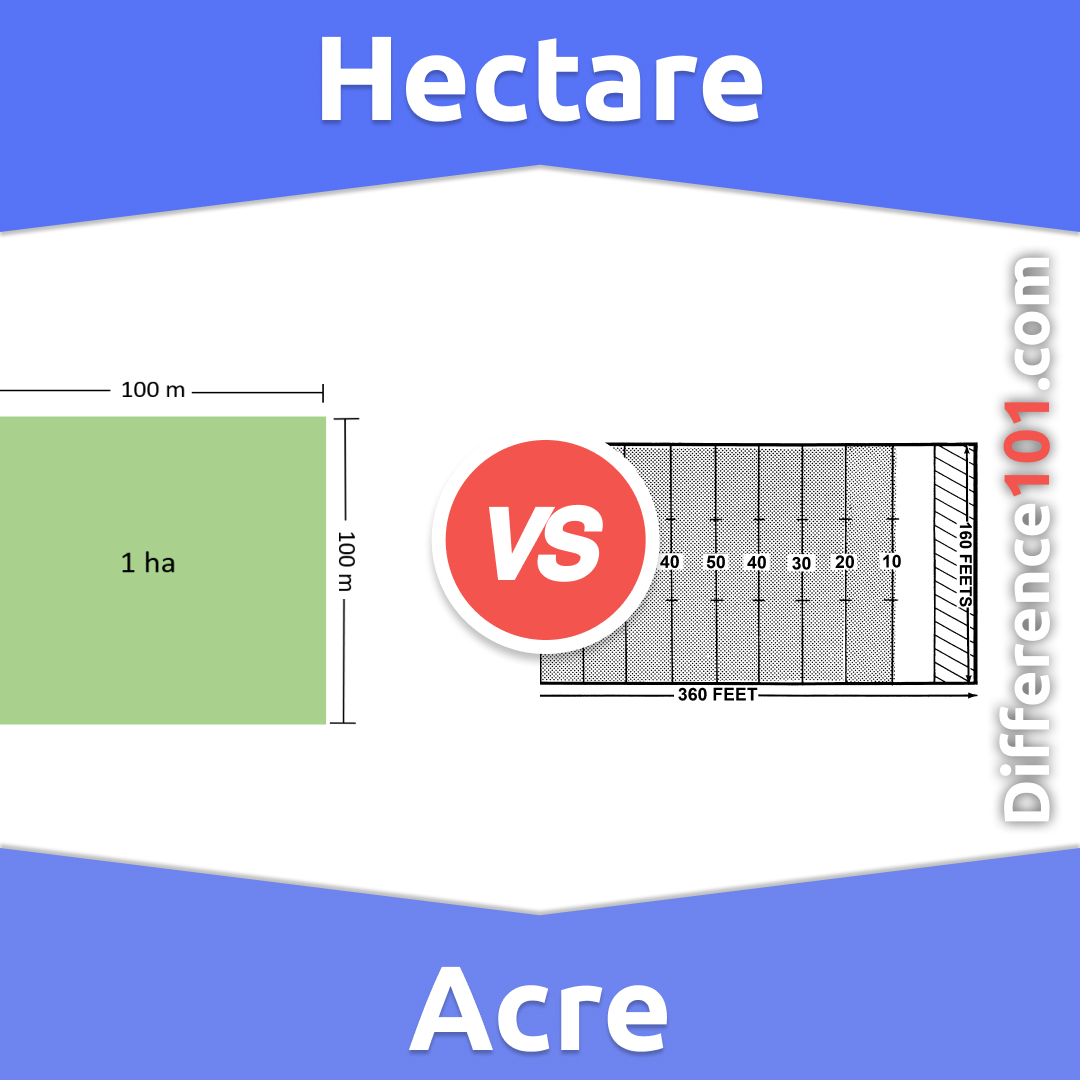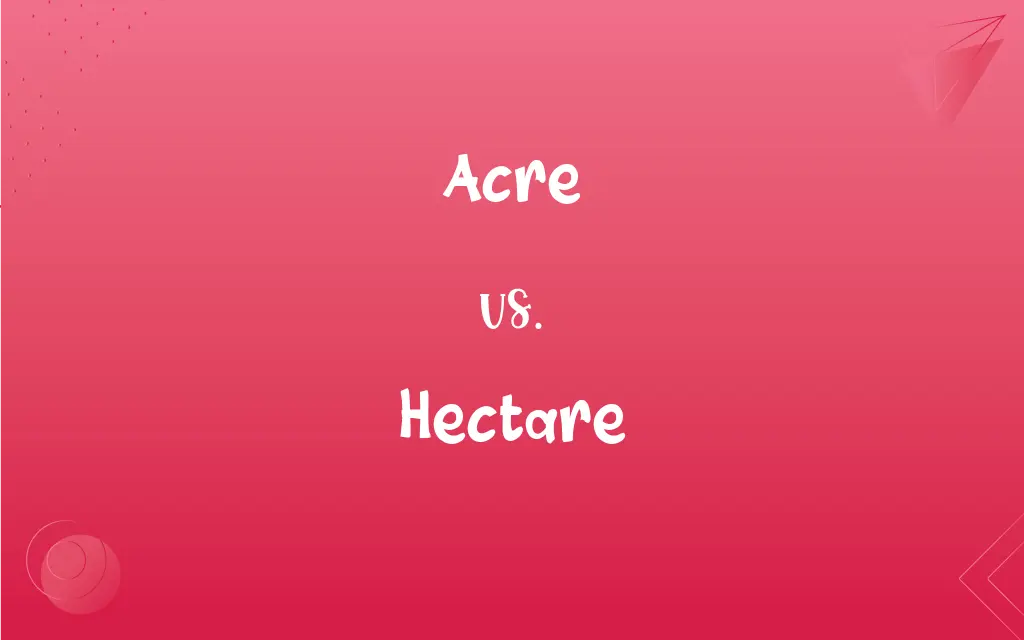Ever found yourself scratching your head trying to figure out the difference between hectare and acre? Well, you're not alone. These two units of land measurement pop up everywhere, from real estate listings to farming stats. But what exactly sets them apart, and why does it matter? Let's dive into the nitty-gritty and clear up the confusion once and for all.
Let’s be honest, understanding land measurements can feel like solving a riddle wrapped in an enigma. But don’t sweat it! By the end of this article, you’ll have all the answers you need to confidently distinguish between a hectare and an acre. Whether you're buying land, comparing property sizes, or just brushing up on your knowledge, this guide has got your back.
Before we jump into the details, let’s set the stage. Both hectare and acre are units of area measurement, but they come from different systems and have distinct values. Understanding these differences isn’t just about math—it’s about making informed decisions. So, grab a coffee, and let’s get started!
What is a Hectare?
First things first, what exactly is a hectare? Think of it as the metric system's way of measuring land. A hectare (ha) is equal to 10,000 square meters. That’s roughly the size of two soccer fields placed side by side. It’s widely used across the globe, especially in countries that rely on the metric system.
Fun fact: The word "hectare" comes from the Greek word "hekaton," meaning "hundred." Makes sense, right? Since a hectare equals 100 ares (another unit of measurement), the name fits perfectly. Hectares are commonly used in agriculture, forestry, and large-scale land transactions.
Why is Hectare Important?
Here’s the deal: hectares are super practical for measuring large areas of land. Imagine trying to describe a farm that spans several thousand square meters—sounds like a mouthful, right? Hectares simplify things by giving us a standardized way to talk about big chunks of land.
- Hectares are ideal for measuring agricultural land.
- They’re widely accepted in international land deals.
- They make it easier to compare land sizes across different regions.
What is an Acre?
Now, let’s shift gears and talk about acres. An acre is an imperial unit of measurement, primarily used in the United States, the United Kingdom, and other English-speaking countries. One acre equals 43,560 square feet or about 4,047 square meters. Picture a football field without the end zones—that’s roughly the size of an acre.
Historically, the acre was defined as the amount of land a pair of oxen could plow in one day. Yeah, we’re talking old-school farming here! Today, acres are still widely used in real estate, agriculture, and land management.
Why is Acre Relevant?
Acres hold a special place in the world of land measurement, especially in countries that follow the imperial system. Here’s why:
- Acres are commonly used in real estate listings, making them familiar to homebuyers.
- They’re perfect for describing smaller plots of land, like suburban lots or small farms.
- They provide a convenient way to compare land sizes within the imperial system.
The Key Difference Between Hectare and Acre
So, what’s the big deal? The main difference lies in their size and the systems they belong to. A hectare is part of the metric system, while an acre is part of the imperial system. In terms of size, one hectare is roughly equivalent to 2.471 acres. That means if you’re converting between the two, you’ll need to do a bit of math.
Size Comparison
To break it down:
- 1 hectare = 10,000 square meters
- 1 acre = 4,047 square meters
See the difference? A hectare is significantly larger than an acre, which makes it more suitable for measuring large areas of land.
When to Use Hectare vs. Acre
Choosing between hectare and acre depends on the context and the region you’re dealing with. Here’s a quick guide:
Use Hectare When...
- You’re working with large areas of land, such as farms or forests.
- You’re in a country that uses the metric system.
- You need a standardized unit for international comparisons.
Use Acre When...
- You’re dealing with smaller plots of land, like residential properties.
- You’re in a country that uses the imperial system.
- You want to align with local customs and practices.
Conversion Made Simple
Converting between hectares and acres might sound tricky, but it’s actually pretty straightforward. Here’s how you do it:
From Hectare to Acre
To convert hectares to acres, multiply the number of hectares by 2.471. For example:
1 hectare × 2.471 = 2.471 acres
From Acre to Hectare
To convert acres to hectares, divide the number of acres by 2.471. For example:
5 acres ÷ 2.471 = 2.023 hectares
Easy peasy, right?
Common Misconceptions About Hectare and Acre
There are a few myths floating around about hectares and acres that we need to clear up:
- Myth #1: Hectares are only used in Europe. Fact: Hectares are widely used worldwide, especially in countries with large agricultural sectors.
- Myth #2: Acres are outdated. Fact: Acres remain relevant, particularly in real estate and agriculture in imperial system countries.
- Myth #3: Converting between the two is complicated. Fact: With a simple formula, conversions are a breeze.
Real-World Examples
Let’s put this knowledge into practice with some real-world examples:
Agriculture
A farmer in France owns a 10-hectare plot of land. To convert this to acres:
10 hectares × 2.471 = 24.71 acres
That’s a pretty sizable farm!
Real Estate
A buyer in the U.S. is looking at a 5-acre lot. To convert this to hectares:
5 acres ÷ 2.471 = 2.023 hectares
Now they can compare it to other properties listed in hectares.
Why Understanding the Difference Matters
Knowing the difference between hectare and acre isn’t just about numbers—it’s about making informed decisions. Whether you’re buying land, planning a project, or simply expanding your knowledge, understanding these units empowers you to navigate the world of land measurement with confidence.
Plus, it’s a great conversation starter at your next dinner party. Trust me, everyone loves a good metric vs. imperial debate!
Conclusion
In a nutshell, the difference between hectare and acre boils down to size and system. Hectares are part of the metric system and are ideal for large-scale measurements, while acres belong to the imperial system and are better suited for smaller plots. Both have their place, and both are equally important depending on the context.
So, the next time someone asks you, "What is the difference between hectare and acre?" you’ll be ready to school them with your newfound expertise. Don’t forget to share this article with your friends and drop a comment below if you’ve got any questions. Let’s keep the learning going!
Table of Contents


